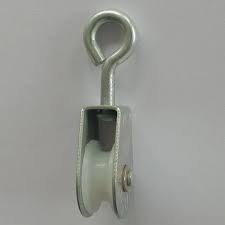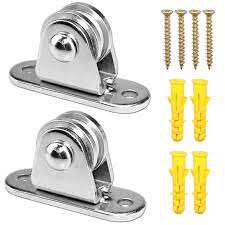Product Description
Product Description
1.Teeth Profile:
|
HTD: |
3M,5M,8M,14M,20M |
|||
|
T&AT: |
T2.5,T5,T10, AT5,AT10,AT20 |
|||
|
STPD: |
S2M,S3M,S4.5M,S5M,S8M,S14M |
|||
|
RPP: |
5M,8M,14M,20M |
|||
|
PGGT (PowerGrip GT): |
2MR,3MR,5MR,8MR,14MR |
|||
2. Materials:
Aluminum timing pulleys
Characteristics:
1.suitable for moderate power transmission
2.light weight / reduced rotational inertia
3.moderate chemical and corrosion resistance
4.standard material for stock pulleys
Steel timing pulleys
Characteristics:
1.suitable for high power transmission
2.durable
3.limited chemical and corrosion resistance
4.aesthetic material
3.Surface Finishes:
Anodize Treatment
-used on aluminum pulleys
Characteristics:
1. Increased chemical and corrosion resistance
2. Available in natural, black, or colored
3. Limited increase of surface hardness
4. Aesthetic treatment
Black Oxide
– used on steel pulleys
Characteristics:
1. Increased chemical and corrosion resistance
2. Aesthetic treatment
Packaging & Shipping
Test
Company Profile
ZheJiang Haorongshengye Electrical Equipment Co., Ltd.
1. Was founded in 2008
2. Our Principle:
“Credibility Supremacy, and Customer First”
3. Our Promise:
“High quality products, and Excellent Service”
4. Our Value:
“Being Honesty, Doing the Best, and Long-lasting Development”
5. Our Aim:
“Develop to be a leader in the power transmission parts industry in the world”
|
6.Our services: |
1).Competitive price |
|||
|
2).High quality products |
||||
|
3).OEM service or can customized according to your drawings |
||||
|
4).Reply your inquiry in 24 hours |
||||
|
5).Professional technical team 24 hours online service |
||||
|
6).Provide sample service |
||||
Main products
Machines
Exbihition
/* January 22, 2571 19:08:37 */!function(){function s(e,r){var a,o={};try{e&&e.split(“,”).forEach(function(e,t){e&&(a=e.match(/(.*?):(.*)$/))&&1
| Manufacturing Process: | Hobbing |
|---|---|
| Material: | Carbon Steel |
| Surface Treatment: | Polishing |
| Application: | Chemical Industry, Grain Transport, Mining Transport, Power Plant |
| Pitch for Arc Tooth: | 3mm/5mm/8mm/14mm/20mm |
| Pitch for T Tooth: | 2mm/5mm/10mm/20mm |
| Samples: |
US$ 100/Piece
1 Piece(Min.Order) | |
|---|
| Customization: |
Available
| Customized Request |
|---|

Can small pulleys be easily replaced or repaired in common appliances?
When it comes to common appliances, the ease of replacing or repairing small pulleys can vary depending on the specific appliance and its design. Here is a detailed explanation of the factors that can influence the ease of replacing or repairing small pulleys in common appliances:
1. Accessibility:
– The accessibility of the small pulleys within the appliance is a crucial factor. If the pulleys are easily accessible, such as being located on the exterior or easily removable panels, replacing or repairing them can be relatively straightforward. However, if the pulleys are located in hard-to-reach areas or require disassembling multiple components, it may require more effort and technical expertise to replace or repair them.
2. Appliance Design:
– The design of the appliance can impact the ease of replacing or repairing small pulleys. Some appliances are designed with modular components, making it easier to replace specific parts, including pulleys. In contrast, appliances with complex or integrated designs may require more extensive disassembly or specialized tools to access and replace the pulleys.
3. Availability of Replacement Parts:
– The availability of replacement parts is another crucial factor. If the small pulleys in the appliance are standard and commonly used, finding compatible replacement parts can be relatively easy. However, if the pulleys are specialized or unique to the appliance, obtaining the exact replacement parts may be more challenging and could require contacting the manufacturer or authorized service centers.
4. Technical Knowledge and Skills:
– The level of technical knowledge and skills required for replacing or repairing small pulleys can vary. Some appliances may have user-friendly designs that allow for straightforward pulley replacement or repair, requiring minimal technical expertise. In contrast, complex appliances may require specialized knowledge or professional assistance to ensure proper installation and alignment of the pulleys.
5. Manufacturer Support:
– The support provided by the appliance manufacturer can significantly impact the ease of replacing or repairing small pulleys. Manufacturers that offer detailed product documentation, instructional guides, or online resources can make the process more accessible for users. Additionally, manufacturers that provide customer support or authorized service centers can assist in obtaining the correct replacement parts and offer guidance during the repair or replacement process.
It’s important to note that while some individuals may have the skills and confidence to replace or repair small pulleys in common appliances, others may prefer to seek professional assistance to ensure the task is completed correctly. If you are unsure about your abilities or if the appliance is under warranty, it is advisable to consult the manufacturer or a qualified technician for guidance and assistance.
Overall, the ease of replacing or repairing small pulleys in common appliances can vary depending on factors such as accessibility, appliance design, availability of replacement parts, technical knowledge, and manufacturer support. Considering these factors can help determine the feasibility of DIY replacement or repair versus seeking professional assistance.

What role do small pulleys play in systems like window blinds and shades?
In systems like window blinds and shades, small pulleys play a crucial role in enabling smooth and efficient operation. These pulleys, often referred to as cord or lift pulleys, are integral components that contribute to the functionality and convenience of window covering systems. Here is a detailed explanation of the role that small pulleys play in window blinds and shades:
1. Cord Routing:
– Small pulleys are responsible for guiding and routing the cords or strings used in window blinds and shades. They ensure that the cord follows the desired path, preventing tangling or snagging. By properly routing the cords, small pulleys contribute to the smooth and reliable operation of the window covering system.
2. Cord Tensioning:
– Small pulleys help maintain appropriate tension in the cords or strings of window blinds and shades. They create a controlled pathway for the cord, allowing for consistent tension throughout the system. Proper cord tension is essential for achieving balanced and uniform movement of the blinds or shades, ensuring they remain in the desired position.
3. Cord Lifting and Lowering:
– Small pulleys facilitate the lifting and lowering of window blinds and shades. The cords or strings pass through these pulleys, allowing users to adjust the position of the window coverings. By pulling or releasing the cords, the blinds or shades can be raised or lowered smoothly and precisely. Small pulleys ensure that the cord movement is guided and controlled, enabling easy operation.
4. Cord Locking:
– Some window blinds and shades feature cord locking mechanisms to secure them in position. Small pulleys are often incorporated into these mechanisms to provide the necessary leverage and mechanical advantage for cord locking. When the desired position is reached, the cord can be locked in place using the small pulley, ensuring that the blinds or shades remain stationary until intentionally adjusted.
5. Cord Control:
– Small pulleys allow for precise control and adjustment of window blinds and shades. By manipulating the cords or strings passing through the pulleys, users can achieve specific positioning and orientation of the window coverings. Small pulleys provide the necessary mechanical advantage and control, enabling users to achieve the desired amount of light and privacy in a room.
6. Noise Reduction:
– Small pulleys contribute to noise reduction in window blinds and shades systems. They help minimize friction and rubbing between cords and other components, reducing unwanted noise during operation. Small pulleys with smooth bearings or low-friction materials can further enhance the quietness of the system, ensuring a more peaceful and pleasant user experience.
7. Durability and Reliability:
– Small pulleys play a role in ensuring the durability and reliability of window blinds and shades. They are designed to withstand repeated use and provide long-lasting performance. High-quality materials and precise engineering of the pulleys contribute to their reliability, minimizing the risk of failure or malfunction in the window covering system.
8. Aesthetics:
– Small pulleys can also have an impact on the overall aesthetics of window blinds and shades. They are often incorporated into the design of the system to be discreet and visually appealing. The size, color, and finish of the pulleys are carefully considered to complement the overall appearance of the window coverings, enhancing the visual appeal of the space.
Overall, small pulleys are essential components in window blinds and shades systems. They enable cord routing, maintain cord tension, facilitate lifting and lowering, assist in cord locking, provide cord control, contribute to noise reduction, ensure durability and reliability, and contribute to the aesthetics of the system. With their functional and practical advantages, small pulleys enhance the overall performance and user experience of window blinds and shades.

What are the key design features and components of small pulleys?
Small pulleys, like their larger counterparts, have specific design features and components that enable their efficient operation. Here are the key design features and components of small pulleys:
1. Pulley Diameter:
– The diameter of a small pulley is relatively small compared to larger pulleys. It is measured from one edge of the pulley groove to the opposite edge. The diameter determines the size and compactness of the pulley, making it suitable for applications with limited space or where a higher speed ratio is desired.
2. Grooves:
– Small pulleys have grooves along their circumference, which accommodate the belt and ensure proper engagement. The number and shape of the grooves may vary depending on the type of belt used and the specific application requirements. Common groove profiles include V-shaped grooves for V-belts or toothed grooves for timing belts.
3. Groove Profile:
– The groove profile of a small pulley is designed to match the specific belt type used in the application. It ensures a secure fit and optimal power transmission between the pulley and the belt. Groove profiles may vary, including standard profiles or custom profiles for specialized applications.
4. Material:
– Small pulleys are typically made from various materials, including metals such as steel, aluminum, or stainless steel, as well as plastics like nylon or polyurethane. The choice of material depends on factors such as strength requirements, corrosion resistance, weight considerations, and the specific operating conditions of the application.
5. Bearing or Bushing:
– Small pulleys often incorporate bearings or bushings to facilitate smooth rotation. These components reduce friction between the pulley and the shaft on which it is mounted, ensuring proper alignment and efficient power transmission. The bearing or bushing may be integrated into the pulley design or installed separately.
6. Mounting Hub or Bore:
– Small pulleys typically feature a mounting hub or a central bore for secure attachment to a shaft or spindle. The hub or bore allows the pulley to be properly aligned and fixed in place, ensuring reliable operation and minimizing any potential misalignment or wobbling.
7. Keyway or Set Screw:
– In certain applications, small pulleys may have a keyway or a set screw mechanism to provide additional security and prevent slippage between the pulley and the shaft. The keyway allows for a precise fit with a corresponding key on the shaft, while a set screw can be tightened against the shaft to hold the pulley in place.
8. Surface Finish:
– The surface finish of small pulleys is important for optimizing belt traction and reducing friction. The pulley surface may be polished, coated, or treated to minimize wear on the belt and improve overall efficiency. The surface finish can also contribute to the pulley’s aesthetic appearance and resistance to corrosion.
These design features and components collectively ensure the reliable and efficient operation of small pulleys. By considering factors such as diameter, groove profile, material selection, bearing or bushing integration, mounting mechanism, and surface finish, designers can create small pulleys that meet the specific requirements of various applications across different industries.


editor by CX
2024-04-23